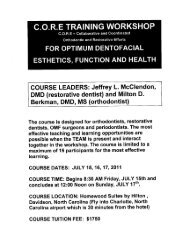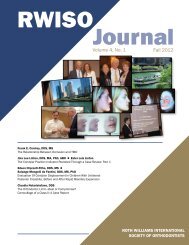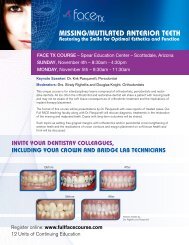2010 RWISO Journal - Roth Williams International Society of ...
2010 RWISO Journal - Roth Williams International Society of ...
2010 RWISO Journal - Roth Williams International Society of ...
Create successful ePaper yourself
Turn your PDF publications into a flip-book with our unique Google optimized e-Paper software.
The Transverse Dimension:<br />
Diagnosis and Relevance to Functional Occlusion<br />
Ryan K. Tamburrino, DMD ■ Normand S. Boucher, DDS ■ Robert L. Vanarsdall, DDS<br />
■ Antonino G. Secchi, DMD, MS<br />
Ry a n K. Ta m b u R R i n o , DMD<br />
rktambur@dental.upenn.edu<br />
■ Clinical Associate—Univ. <strong>of</strong> Penn.<br />
School <strong>of</strong> Dental Medicine, Dept.<br />
<strong>of</strong> Orthodontics<br />
noR m a n d S. bo u c h e R, ddS<br />
■ Clinical Associate Pr<strong>of</strong>essor—<br />
Univ. <strong>of</strong> Penn. School <strong>of</strong> Dental<br />
Medicine, Dept. <strong>of</strong> Orthodontics<br />
Rob e R T L. Va n a R S d a L L , ddS<br />
■ Pr<strong>of</strong>essor and Chair—<br />
Univ. <strong>of</strong> Penn. School <strong>of</strong> Dental<br />
Medicine, Dept. <strong>of</strong> Orthodontics<br />
anT o n i n o G. Se c c h i , DMD, MS<br />
■ Assistant Pr<strong>of</strong>essor <strong>of</strong> Orthodontics,<br />
Clinician Educatorand Clinical<br />
Director—Univ. <strong>of</strong> Penn. School <strong>of</strong><br />
Dental Medicine, Dept. <strong>of</strong> Orthodontics<br />
For complete contributor information, please see end <strong>of</strong> article.<br />
Introduction<br />
The goals <strong>of</strong> orthodontic treatment are well established<br />
for static and functional occlusal relationships. In order<br />
to achieve Andrews’ six keys to normal occlusion for the<br />
dentition, 1 the jaws must be optimally proportioned in<br />
three planes <strong>of</strong> space and positioned in CR. Orthodontists<br />
have a multitude <strong>of</strong> cephalometric analyses available to diagnose<br />
skeletal and dental variations <strong>of</strong> the sagittal and<br />
vertical dimensions. 2–6 Several analyses for the transverse<br />
dimension are also available, 3,6,7 but these analyses are not<br />
well accepted as forming part <strong>of</strong> a traditional orthodontic<br />
diagnosis.<br />
In the sagittal dimension, when the jaws do not relate<br />
optimally, the dentition will attempt to compensate, resulting<br />
in excessively proclined or retroclined anterior teeth. In the<br />
transverse dimension, when the jaws do not relate optimally,<br />
usually due to a deficiency in the width <strong>of</strong> the maxilla, 7,8 the<br />
teeth will erupt into a crossbite or reconfigure their inclinations<br />
to avoid a crossbite. This compensation typically<br />
involves lingual tipping <strong>of</strong> the mandibular posterior teeth,<br />
which are then described as being excessively negatively inclined.<br />
In addition, the maxillary posterior teeth are tipped<br />
Summary<br />
Much focus <strong>of</strong> orthodontic diagnoses has been placed on the sagittal and vertical<br />
dimensions. However, a proper evaluation <strong>of</strong> the transverse dimension<br />
must also have equal importance. Research has shown that interferences from<br />
an exaggerated curve <strong>of</strong> Wilson due to a maxillary transverse deficiency play<br />
a role in centric relation (CR)/central occlusion (CO) discrepancies, adverse<br />
periodontal stresses, and crani<strong>of</strong>acial development. This article illustrates<br />
three scientifically validated methods for evaluating the transverse dimension:<br />
Ricketts’ P-A cephalometric analysis, Andrews’ Element III analysis, and the<br />
University <strong>of</strong> Pennsylvania Cone-Beam CT transverse analysis. The aim is to<br />
show methods using traditional cephalometry, study models, and cone-beam<br />
computed tomography, not to compare one method to another. The reader<br />
may then choose to use the method that is most appropriate for his practice.<br />
facially. These teeth are then described as being excessively<br />
positively inclined (Figure 1).<br />
Figure 1 Example <strong>of</strong> excessive tooth angulations.<br />
Transverse Deficiency and CR/CO Discrepancy<br />
In the prosthodontic literature, these transverse tooth compensations<br />
have been graphically illustrated with a crossarch<br />
arc constructed through the buccal and palatal cusps <strong>of</strong><br />
<strong>RWISO</strong> <strong>Journal</strong> | September <strong>2010</strong><br />
11








